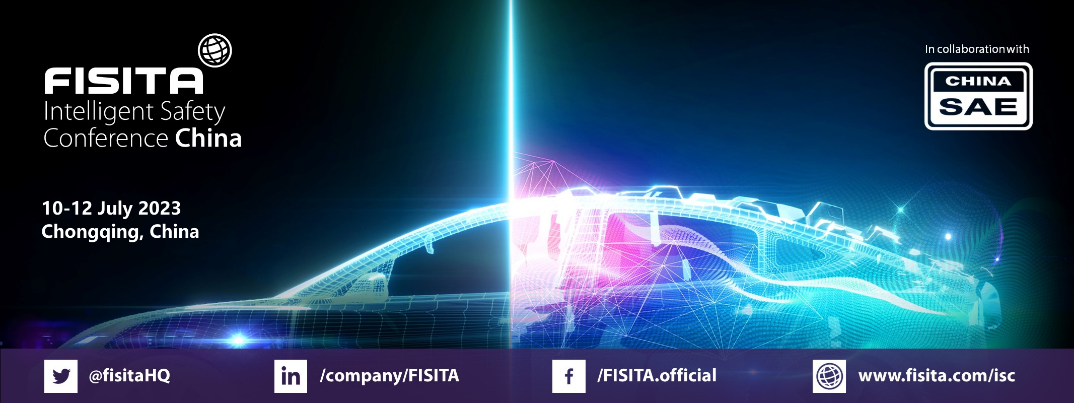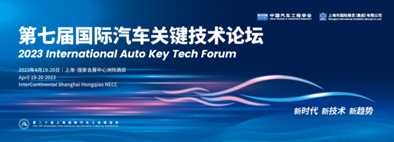

|
The journal Automotive Innovation is sponsored by China SAE,
published through Springer, distributed around the world, and reflects the top-level
research and technical advance of automotive engineering. Automotive Innovation newsletter in March includes the following contents: 1. Article Recommendation——Four papers on Electric Vehicles 2. China SAE News: · ISC 2023 to be held on 10-12 July
2023 in Chongqing |

   
|
Effects of Driver Response Time Under Take-Over Control Based
on CAR-ToC Model in Human–Machine Mixed Traffic Flow Yucheng Zhao, Haoran Geng, Jun Liang, Yafei Wang, Long Chen, Linhao Xu, Wanjia Wang |
||
| The take-over control (ToC) of human–machine interaction is a hotspot. From automatic driving to manual driving, some factors affecting driver response time have not been considered in existing models, and little attention has been paid to its effects on mixed traffic flow. This study establishes a ToC model of response based on adaptive control of thought-rational cognitive architecture (CAR-ToC) to investigate the effects of driver response time on traffic flow. A quantification method of driver’s situation cognition uncertainty is also proposed. This method can directly describe the cognitive effect of drivers with different cognitive characteristics on vehicle cluster situations. The results show that when driver response time in ToC is 4.2 s, the traffic state is the best. The greater the response time is, the more obvious the stop-and-go waves exhibit. Besides, crashes happen when manual vehicles hit other types of vehicles in ToC. Effects of driver response time on traffic are illustrated and verified from various aspects. Experiments are designed to verify that road efficiency and safety are increased by using a dynamic take-over strategy. Further, internal causes of effects are revealed and suggestions are discussed for the safety and efficiency of autonomous vehicles. | |||
|
Keywords: Take-over control · CAR-ToC model · Driver response time · Mixed traffic flow
characteristics Zhao, Y., Geng, H., Liang, J. et al.: Effects of driver response time under take-over control based on CAR-ToC model in human–machine mixed traffic flow. Automot. Innov. 6(1), 3–19 (2023) |
|||
| Full Paper Reading>> | |||
   
|
Drivers’ EEG Responses to Different Distraction Tasks
Guofa Li, Xiaojian Wu, Arno Eichberger, Paul Green, Cristina Olaverri-Monreal, Weiquan Yan, Yechen Qin, Yuezhi Li |
||
| Driver distraction has been deemed a major cause of traffic accidents. However, drivers’ brain response activities to different distraction types have not been well investigated. The purpose of this study is to investigate the response of electroencephalography (EEG) activities to different distraction tasks. In the conducted simulation tests, three secondary tasks (i.e., a clock task, a 2-back task, and a navigation task) are designed to induce different types of driver distractions. Twenty-four participants are recruited for the designed tests, and differences in drivers’ brain response activities concerning distraction types are investigated. The results show that the differences in comprehensive distraction are more significant than that in single cognitive distraction. Friedman test and post hoc two-tailed Nemenyi test are conducted to further identify the differences in band activities among brain regions. The results show that the theta energy in the frontal lobe is significantly higher than that in other brain regions in distracted driving, whereas the alpha energy in the temporal lobe significantly decreases compared to other brain regions. These results provide theoretical references for the development of distraction detection systems based on EEG signals. | |||
|
Keywords: Driving safety · Driver distraction · EEG · Autonomous vehicle
Li, G., Wu, X., Eichberger, A. et al.: Drivers’ EEG responses to different distraction tasks. Automot. Innov. 6(1), 20–31 (2023) |
|||
| Full Paper Reading>> | |||
   
|
Towards Human-Vehicle Interaction: Driving Risk Analysis Under
Different Driver Vigilance States and Driving Risk Detection Method
Yingzhang Wu, Jie Zhang, Wenbo Li, Yujing Liu, Chengmou Li, Bangbei Tang, Gang Guo |
||
| The driver's behavior plays a crucial role in transportation safety. It is widely acknowledged that driver vigilance is a major contributor to traffic accidents. However, the quantitative impact of driver vigilance on driving risk has yet to be fully explored. This study aims to investigate the relationship between driver vigilance and driving risk, using data recorded from 28 drivers who maintain a speed of 80 km/h on a monotonous highway for 2 hours. The k-means and linear fitting methods are used to analyze the driving risk distribution under different driver vigilance states. Additionally, this study proposes a research framework for analyzing driving risk and develops three classification models (KNN, SVM, and DNN) to recognize the driving risk status. The results show that the frequency of low-risk incidents is negatively correlated with the driver's vigilance level, whereas the frequency of moderate-risk and high-risk incidents is positively correlated with the driver's vigilance level. The DNN model performs the best, achieving an accuracy of 0.972, recall of 0.972, precision of 0.973, and f1-score of 0.972, compared to KNN and SVM. This research could serve as a valuable reference for the design of warning systems and intelligent vehicles. | |||
|
Keywords: Driving risk · Driver vigilance · Driving risk detection · Human–machine
interaction · Deep Neural Network Wu, Y., Zhang, J., Li, W. et al.: Towards human-vehicle interaction: driving risk analysis under different driver vigilance states and driving risk detection method. Automot. Innov. 6(1), 32–47 (2023) |
|||
| Full Paper Reading>> | |||

| ISC 2023 to be held on 10-12 July 2023 in Chongqing | |||
 China SAE and FISITA are delighted to confirm that the fifth FISITA Intelligent Safety Conference (ISC 2023) will take place 10-12 July 2023, in Chongqing, China, with physical and online participation available to registered participants. ISC 2023 will bring together renowned experts from across the globe to discuss some of the most pressing issues in the realm of future mobility safety. These topics include SOTIF, Cybersecurity, Human Factors, AI, and Smart Safety Protection. We cordially invite you to participate in this exciting conference and stay tuned for the opening of registration. To learn more about ISC 2023, please visit our website at www.fisita.com/isc . |
|||
| International Auto Key Tech Forum 2023 to be held on 19-20 April 2023 in Shanghai | |||
 The 2023 International Auto Key Technology Forum is scheduled to take place on April 19-20, 2023, at the Intercontinental Hotel of National Convention and Exhibition Center Shanghai. This event is jointly organized by the China SAE and Shanghai International Exhibition Group. The forum will feature three sub-forums, namely "Energy-saving and New Energy Vehicle Technology", "Hydrogen Energy and Fuel Cell Technology", and "Intelligent and Connected Vehicle Technology". The sub-forums will offer a platform for exchanging views on the latest technologies and engineering practices. We strongly encourage all interested parties to register for the conference at the earliest, as the registration deadline is April 19. For further details about the conference, please click here . |
|||
| China SAE launched “Bluebook of Intelligent Connected Vehicle” | |||
 The Bluebook of Intelligent Connected Vehicle (2022) was recently released after a year of preparation. This annual research report on the intelligent connected vehicle (ICV) industry is jointly organized by the China SAE, the National Intelligent Connected Vehicle Innovation Center, and the China Intelligent Connected Vehicle Industry Innovation Alliance. This publication is the fifth volume of the Bluebook on ICVs, which was first published in 2018. Based on the research experience of the previous four years, the 2022 Bluebook closely follows the industry hotspots and includes seven chapters: General Report, Industry Chapter, Regulations and Standards Chapter, Technology Chapter, Topical Topics Chapter, Application Chapter, and Progress of ICV Standards Appendix. There are 32 reports in total, which systematically and comprehensively discuss the current situation and development trends of China's ICV industry in 2022. For further details, please click here to view. |
|||

|
Automotive Innovation Sponsored by China SAE and published globally via Springer Nature, Automotive Innovation aims to be a world-class journal that provides abundant sources of innovative findings for automotive engineers and scientists. The journal is published quarterly, ensuring high-quality papers satisfying international standards. With the editorial board consisting of world-renowned experts, it has attracted readers from 72 countries and regions. The highest download of a single article wins more than 32,000. The journal is indexed in Ei Compendex, ESCI, and Scopus (CiteScore=5.5). The journal provides a forum for the research of principles, methodologies, designs, theoretical background, and cutting-edge technologies in connection with the development of vehicle and mobility. The main topics cover: energy-saving, electrification, intelligent and connected, safety, and emerging vehicle technologies. Editors-in-Chief Jun Li, Academician of CAE, President of China SAE, Professor of Tsinghua University Frank Zhao, Honorary Lifetime President of FISITA, Director of Tsinghua Automotive Strategy Research Institute, Professor of Tsinghua University Honorary and Founding Executive Editor-in-Chief Prof. Fangwu (Mike) Ma Executive Associate Editor-in-Chief Prof. Xinjie Zhang, Professor of Jilin University |
||||
|
Paper submission and browse
www.ChinaSAEJournal.com.cn www.springer.com/42154 Contacts: Ms. Lily Lu Tel: +86-10-50950101 Email: jai@sae-china.org 
|

|
|||
|
Sponsored by |
Published by
|
|||